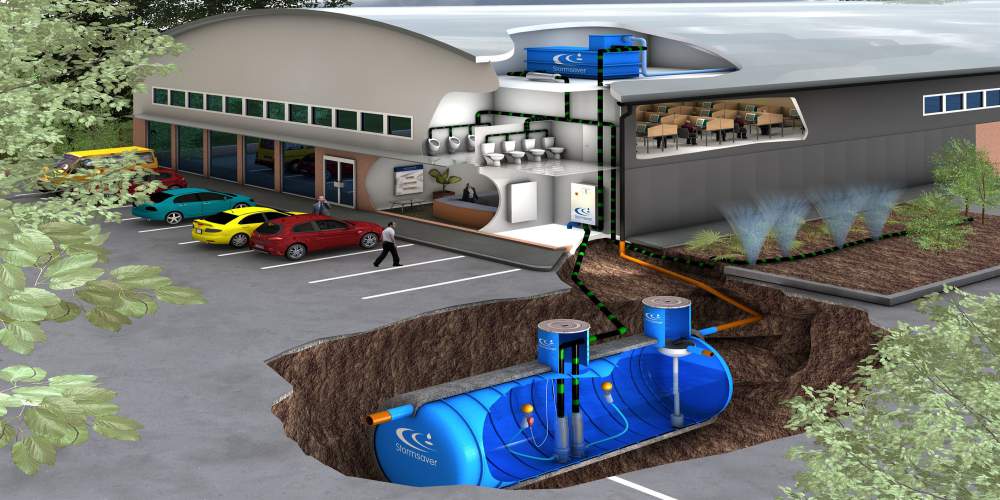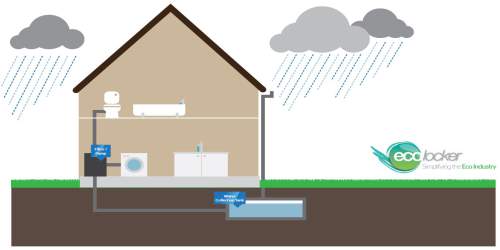Read Time : 3 Minutes
Large Scale & Commercial Rainwater Harvesting
Rainwater harvesting on a large or commercial scale is beginning to become increasingly important in the UK and the government has included legislation that new builds now have to take into account how they deal with ‘run-off’ water.
The Code for Sustainable Homes also actively encourages the fitting of underground water tanks. The technology for large commercial and industrial rainwater harvesting is the same for smaller installations, it’s simply the size and scale that is different.  Image courtesy of Stormsaver Ltd
Image courtesy of Stormsaver Ltd
Rainwater Harvesting in the UK
Whilst the UK has often been accused of being a little late in the rainwater harvesting arena compared to our neighbours in the rest of the world, more effort is beginning to be made with initiatives that promote water conservation and management particularly in large urban areas.
- One of the most iconic and controversial buildings in London, the Millennium Dome, uses a water collection system to catch the run-off from its curved structure. With a surface area of 90,000 m² the water is collected through a gutter and is passed through a series of hoppers to the main storage system.
- The Museum of London has also embraced the notion of large scale rainwater harvesting with its 850 m² roof and a 25,000 litre storage tank. They have also gone hi-tech, linking up the performance of the installation with their own building management system. The water is supplied to the toilets in the bar and theatre and used to irrigate their green roof.
- The Olympics in London came to the rainwater harvesting party when the Velodrome was used for supplying the toilets and gardens. Half the 13,000 m² roof was used for water collection and reduced mains water usage by 40%.
- At the Honda Dealership in Manchester a 30,000 litre tank was installed with a catchment roof area of 1,500 m² providing a water supply of around 85,000 litres a year and saving them nearly £1,700 in reduced mains charges.
- The Imperial Tobacco Head Office in Bristol used its 2,700 m² roof to feed into a 32,000 litre tank that was used to supply its toilets, with an estimated saving of over a million litres a year.
- In Rochdale, a large distribution area has taken to rainwater harvesting in a big way, saving a staggering 23 million litres a year. Three systems spread over the site were installed, creating a return on investment in just one year.
COMPARE PRICES FROM LOCAL INSTALLERS
Compare prices from local companies fast & free
Enter your postcode to compare quotes from leading professionals. We promise to keep your information Safe & Secure. Privacy Policy
Industrial and Commercial Rainwater Harvesting
The benefits to industry of a good commercial rainwater harvesting scheme are numerous and far reaching. Our industries use a large amount of water for their processes and the installation of an efficient system can help reduce their reliance on a mains supply by between 40 and 50%.
- Rainwater harvesting now makes financial sense because companies can lock into the Enhanced Capital Allowance Scheme that provides funding for water efficient technologies.
- It’s better for industrial machinery because rainwater is kinder than a treated mains supply of ‘harder’ water.
- Most industrial and commercial premises have a large amount of roof space that can easily be converted to improve rainwater harvesting.
- In the last 20 years, the average water bill for industrial premises has increased by almost 40% which means that significant savings can be made, now and in the future.
- For commercial rainwater harvesting, larger sites tend to enjoy a quicker return on investment that makes it well worthwhile for industry and substantial commercial developments.

Rainwater harvesting on commercial buildings is an eco-friendly and sustainable approach that has gained significant momentum in recent years. As water scarcity becomes an increasing concern, businesses are recognizing the importance of conserving this precious resource. Rainwater harvesting involves capturing and storing rainwater that falls on rooftops, parking lots, and other surfaces for later use.
The use of rainwater harvesting on commercial buildings offers several benefits. First and foremost, it reduces the demand for municipal water supply, easing the burden on local water sources and infrastructure. This, in turn, can lead to cost savings for businesses as they rely less on expensive treated water. Additionally, rainwater is naturally soft and free from chemicals, making it ideal for various non-potable uses such as irrigation, flushing toilets, and cooling systems.
Rainwater harvesting can enhance a company's sustainability credentials and corporate social responsibility efforts. By implementing such green initiatives, businesses can improve their reputation among environmentally conscious consumers and stakeholders. Moreover, some regions offer incentives or tax breaks to businesses that adopt rainwater harvesting systems, encouraging broader adoption.
Rainwater Harvesting Across the World
As we live in a fairly temperate climate, the UK has come a little later to the benefits of rainwater harvesting than some other countries across the world.
- With little in the way of land resources, Singapore has to make the most of what it gets. The majority of the population live in high rise blocks and many of these have been converted with rainwater harvesting on a grand scale. Individual collection systems are installed on flats to use as potable water.
- The Ryogoku Kokugikan Arena in Tokyo uses its full 8,000 m² roof to serve a rainwater harvesting system, draining into a massive 1,000 cubic metre tank below the building. Japan has embraced rainwater harvesting technology on a large scale, introducing it to all their main buildings.
- In Berlin they have gone for a collective approach at the DaimlerChrysler Potsdamer Platz. A combined roof top area of 32,000 m² collects rainwater off 19 buildings to provide potable water from a 3,500 cubic metre tank.
Discover some more international rainwater harvesting projects.
The Future of Rainwater Harvesting in the UK
The UK industry is beginning to grow, particularly in the commercial arena where the benefits are much greater and the chance of a return on investment over a short period is much more likely than in the domestic market. With increasing demand we can expect to see more innovation in the rainwater harvesting arena as we attempt to make the most of our dwindling resources. Find out who manufacturers rainwater harvesting systems in the UK.
Find a local installer
Welcome to the biggest directory of UK renewable energy companies





 Types of Rainwater Harvesting System
Types of Rainwater Harvesting System


